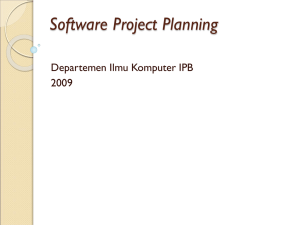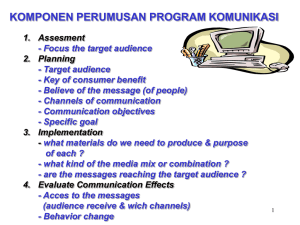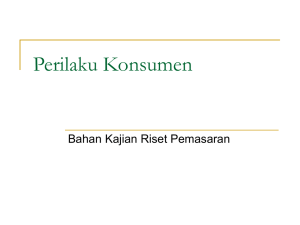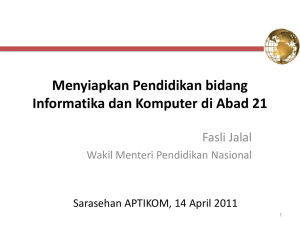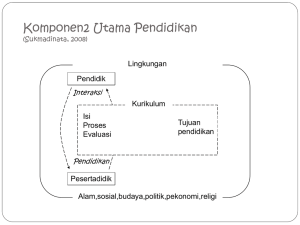quality of care 4 , patient safety
advertisement
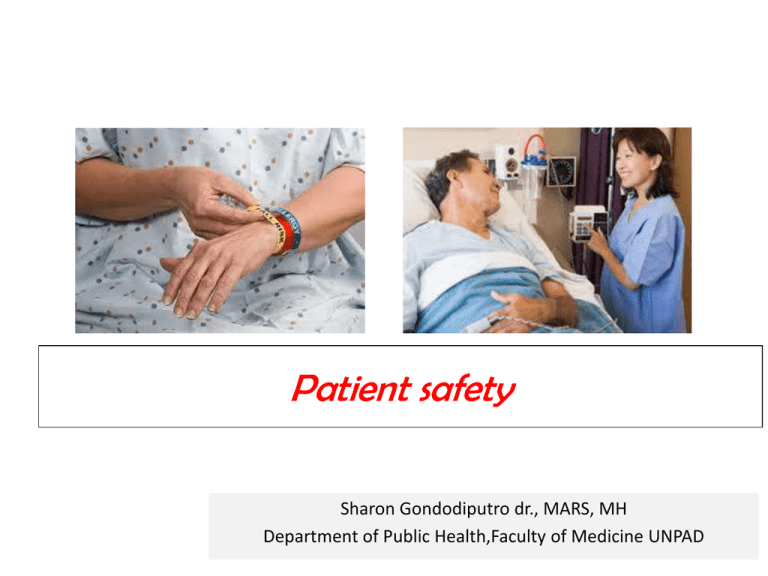
Patient safety Sharon Gondodiputro dr., MARS, MH Department of Public Health,Faculty of Medicine UNPAD Topics 1. 2. 3. 4. 5. Definition patient safety Definition of error Human factors in patient safety Problem solving cycle in patient safety 7 steps of patient safety Definition • WHO, A discipline in the health-care sector that : – applies safety science methods towards the goal of achieving a trustworthy system of health-care delivery – an attribute of health-care systems – it minimizes the incidence and impact of and maximizes recovery from adverse events • Permenkes 1691 : suatu sistem dimana rumah sakit membuat asuhan pasien lebih aman yang meliputi: – asesmen risiko, identifikasi dan pengelolaan hal yang berhubungan dengan risiko pasien, – pelaporan dan analisis insiden, – kemampuan belajar dari insiden dan – tindak lanjutnya serta implementasi solusi untuk meminimalkan timbulnya risiko dan mencegah terjadinya cedera yang disebabkan oleh kesalahan akibat melaksanakan suatu tindakan atau tidak mengambil tindakan yang seharusnya diambil. Definisi Insiden ( Permenkes 1691 ) Kejadian Tidak Diharapkan, (KTD) : insiden yang mengakibatkan cedera pada pasien Kejadian sentinel : KTD yang mengakibatkan kematian atau cedera yang serius. Insiden: setiap kejadian yang tidak disengaja dan kondisi yang mengakibatkan atau berpotensi mengakibatkan cedera yang dapat dicegah pada pasien Kejadian Tidak Cedera (KTC ): insiden yang sudah terpapar ke pasien, tetapi tidak timbul cedera. Kondisi Potensial Cedera (KPC): kondisi yang sangat berpotensi untuk menimbulkan cedera, tetapi belum terjadi insiden Kejadian Nyaris Cedera (KNC) : terjadinya insiden yang belum sampai terpapar ke pasien. Human factors design principles Psychomotor - Hands Senses - Vision - Hearing I N T E R F A C E Input Devices - Buttons Output - Display - Sound US Department of Veteran affairs Traps in health care? • look-alike and sound-alike pharmaceuticals • equipment design ○ e.g. infusion pumps Ruang ICU What is an error? • the failure of a planned action to achieve its intended outcome • a deviation between what was actually done and what should have been done Reason • A definition that may be easier to remember is: ○ “Doing the wrong thing when meaning to do the right thing.” Situations associated with an increased risk of error • unfamiliarity with the task* • inexperience* • shortage of time • inadequate checking • poor procedures • poor human equipment interface Vincent * Especially if combined with lack of supervision Individual factors that predispose to error • limited memory capacity • further reduced by: ○ fatigue ○ stress ○ hunger ○ illness ○ language or cultural factors ○ hazardous attitudes Don’t forget …. If you’re – H ungry – A ngry – L ate or – T ired ….. H A L T A performance-shaping factors “checklist” Jensen, 1987 Sistem Pelayanan Kesehatan di Rumah Sakit Comsumption of resources How the process of health services Who provide health care Who receive health care Feedback dan TQM 5.Translating Evidence into safer care (pelaksanaan dan perencanaan kembali) 1. Measuring harm (mengukur insiden) 4.Evaluating Impact (evaluasi impact) 2. Understanding causes (mengerti/mencari penyebab) 3.Identify solution (Identifikasi solusi) 1. Measuring harm Sasaran Keselamatan Pasien 1. 2. 3. 4. 5. 6. Ketepatan identifikasi pasien: dua identitas atau penggunaan gelang pasien Peningkatan komunikasi yang efektif: persentase kelengkapan rekam medik,audit klinik/keperawatan Peningkatan keamanan obat yang perlu diwaspadai: persentase pemberian obat yang salah Kepastian tepat-lokasi, tepat-prosedur, tepat-pasien operasi: persentase penandaan lokasi operasi Pengurangan risiko infeksi terkait pelayanan kesehatan: persentase tertusuk jarum, ILO, ISK, pneumonia, cuci tangan yang benar Pengurangan risiko pasien jatuh: lantai licin,penggunaan tempat tidur berpagar, asessment pasien risiko jatuh 2. Understand causes Reason’s swiss model: Multiple factors usually involved Vincent funnel : Multiple factors usually involved organizational factors environmental factors team factors technology and tool task factors provider patient 1. 2. Cause 1. 2. 3. Organizational/technical factor Human factor Level 1: communication Level 2: patient management Level 3: Clinical performance pra, durante dan post intervention Type Domain 1. 2. Medical :fisik,psikis Nonmedical: legal, economy,social Impact 1. 2. 3. 4. Setting/location Staff Patient Target 3. Identify Solution Causes Type Domain Impact Preventive/Mitigation 1. 2. 3. Universal Selective Indication 5.Translating Evidence into safer care (pelaksanaan dan perencanaan kembali) 1. Measuring harm (mengukur insiden) 4.Evaluating Impact (evaluasi impact) 2. Understanding causes (mengerti/mencari penyebab) 3.Identify solution (Identifikasi solusi) • A safety culture is where organisations, practices, teams and individuals have a constant and active awareness of the potential for things to go wrong. Both the individuals and the organisation are able to acknowledge mistakes, learn from them, and take action to put things right. Being open and fair means sharing information openly and freely with patients and their families, balanced by fair treatment for staff when an incident happens. This is vital for both the safety of patients and the wellbeing of those who provide their care.

